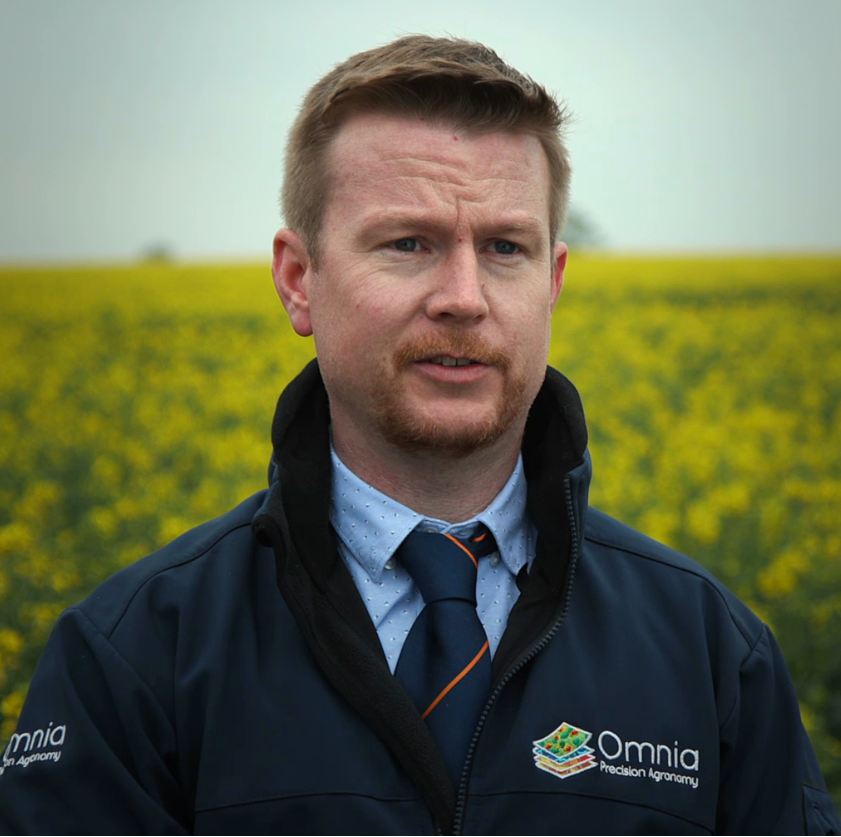Return to the Case Studies hub page
While arable producers have generally led the way with yield mapping in recent years, the technology is also helping improve forage production too. John Cunningham-Jardine of the 525ha (1,300-acre) Tinwald Estate in Dumfriesshire, is one farmer that is seeing the benefits yield and soil mapping can bring to forage crops.
Working with Omnia’s Lewis McKerrow and Hutchinsons’ Jim Clark, John has digitally mapped his soils and yields of forage crops destined for the farm’s 1MWe biogas plant, and this data has been uploaded to and analysed by the Omnia precision farming platform.

Lewis McKerrow – Head of Field-Based IT
Using the results of Omnia’s analysis, John selected a number of fields, covering some 60ha, for closer inspection with detailed TerraMap soil scans with the aim to reveal the causes of their underlying issues.
This is a great demonstration of how, while yield mapping is a great management tool, clearly showing the variations within fields, it only provides half the story. You have to go on to identify exactly what is causing that variability to see how it can be addressed.
This is where TerraMap’s high-definition soil scanning came to the fore – identifying the limiting factors to yield, to make sure nothing was missed.
Starting with pH
Soil pH was one of the first issues to be examined, as low pH is known to significantly affect nutrient availability and subsequent crop growth.
“In the northern block of three Italian ryegrass fields furthest from the main farm, pH ranged from 5.2-5.9, which is below the optimum 6-6.5 for healthy grass growth. Indeed, yields in this area were poor compared to other areas of the farm, in what was a very challenging season”, Mr Cunningham-Jardine said. However, he acknowledges these outlying fields have been down to grass for many years and have historically not received the same attention as those closer to the main farm.
Soil pH in the middle block was generally within the target range, and also achieved the best average yields at around 14 t/ha. Fields on the southern side showed the widest in-field pH variation, from 5.6 to 6.5, which correlated with the significant variability in yield across the individual fields.
Based on this insight, the three fields with the widest pH variation were then earmarked for variable rate lime application to minimise the chances of over or under-applying lime when using a blanket rate across the field. This was done to improve nutrient uptake, crop growth and raise yields closer to those achieved in the middle block.
Cost Saving
Running the variable rate programme through Omnia showed that they would need 77 tonnes of lime, which was much less than the 183 tonnes required at a standard flat rate of 5t/ha. Using 106 tonnes less, at, say £20/t, is a big saving of more than £2,100, just from these few fields.
Potash
Potash was another key factor examined, as it is an essential nutrient for ‘stemmy’ forage crops. Much of the estate is on sloping, light land, which combined with the high annual rainfall of around 44in (1,120mm), means nutrient leaching is a constant factor. A key reason for building the AD plant in 2015 was to provide a long- term source of natural fertiliser from the use of digestate.
Again, the northern block of land showed some deficiencies, with potash status ranging from 0-1. Organic matter content was generally high in these fields having been in grass for a long time. All fields used for the AD plant receive applications of digestate and the farm plan ensures that the outlying fields are not neglected.
Potash levels in the middle block were generally within the target range of 1-3, while some areas in the southern fields recorded very high potash status of 3-5, although they had relatively low organic matter content. Future organic matter additions may therefore be focused more in these areas.
Mr Cunningham-Jardine admits to being sceptical of digital mapping at first, but after some convincing says he can now see the benefits. “I like the fact Omnia is very easy to use and the maps make it visually clear to see what’s going on. It’s now a question of working with my contractor to keep things progressing and do more mapping this year.”
“Maps clearly show the variations within fields, especially along turning headlands, but you have to identify exactly what is causing that variability to see how it can be addressed, which is where TerraMap comes to the fore.”
Fine-Tuning Biogas Output
The farm’s AD consultant William Tuer also recognises the importance of digital mapping for optimising both the quantity and quality of feedstocks, which in turn benefits the efficiency of AD units, in much the same way as forage quality affects animal productivity.
“There’s a very strong link between healthy crops and the health of an AD plant, especially for micronutrients and trace elements; a deficiency in the crop soon comes through to the AD plant, which can reduce performance.”
Equally, the digestate produced is a highly effective source of nitrogen, phosphate and potash, and having detailed mapping information allows its application to be targeted most effectively, he says.
“The AD plant has made this farm very accountable to its production and as we look more closely at what land is delivering, so poorer areas will have to up their game for the business.”